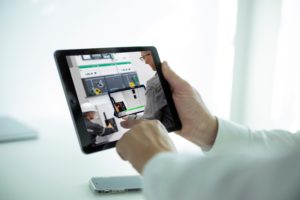Scarcity of water resources, growth in urban population, environmental regulations and process inefficiencies are all contributing to a crisis in the Water & Wastewater industry. It is estimated that the amount of energy wasted as a result of traditional methods of water processing and delivery can be cut by up to 25%. The urban population of the world is forecast to grow to 6.3 billion people in 2050, from 3.4 billion in 2009 (1).
Figure 2: Energy consumed by Industrial motorsEnergy efficiency is a point of main concern as a quarter of the energy consumed by industrial motors is used by PUMPS (see Figure 2).It is estimated that 75% of pump systems are oversized, many by more than 20% (2). Electricity costs account for 40% of the total cost of ownership (TCO) of a pump.
The solution for the issues mentioned above lies in Smart Pumping (also termed as Intelligent Pumping) along with use IIoT. These approaches result in energy savings, increased equipment lifetime, and maintenance cost reductions by providing higher quality and precise data.
Figure 3: Smart pumping systems along with IIoT reduces the total cost of ownershipA “Smart Pumping” system has the ability to combine greater efficiencies with sensors and software to regulate and control flow and pressure. IIoT incorporates machine learning and big data technology, harnessing sensor data, machine-to-machine (M2M) communication and automation technologies that have existed in industrial settings for years.
Figure 4: Monitoring of the energy related attributes provides Pump owners possibility to optimize energy usage.A Smart Pumping system along with IIoT enables energy efficient systems through:
- Monitoring pumps which helps operators to detect higher energy usage
- Libraries and algorithms to ensure that pumps are running in energy efficient manner
- Pumps driven by variable speed drives which can save up to 30% energy compared to fixed speed pumps (2)
A pumping system is considered “efficient” if it is available, reliable and compliant standards defined by governing bodies like EuroPump and AHR. With Smart pumping along with IIoT, efficient systems can be realized by:
- Establishing preventive maintenance plans for systematic inspection to detect potential failures
- Enabling condition-based maintenance by monitoring pumping system data for an accurate status and risk assessment
Traceability:
By remaining connected with pumps, the manufacturers know the location of the pumps and are also able to provide timely support and spare parts to their customers.
The connected Variable speed drives with active QR codes can be used for diagnostics and also to give information easily to operators for support.
Conclusion: Start small, start smart NOW
- Introduce energy measuring devices into system architectures
- Use controllers with intelligent applications for better protection and reduced commissioning time, while following guidelines for standards as set by local and global organizations
- Replace fixed speed pumps with variable speed pumps
- For “smart” visibility of pumping systems use remote monitoring for maintenance and energy efficiency
To discover more…you can download the entire presentation as shown at Hannover Messe 2016.
Contributing Author: Eric Vatonne
Eric is the Schneider Electric Marketing Manager for pumping offer in Machine Solutions. More than 25 years of experience in the automation and international business with Machines manufacturers in every continent.
Notes:(1): WEF (World Economic Forum). 2009. Energy Vision Update 2009: Thirsty Energy: Water and Energy in the 21st Century. Geneva/Englewood, Colo., WEF/Cambridge Energy Research Associates. (Accessed 30 April 2011.)
IEA (International Energy Agency). 2006. World Energy Outlook 2006. Paris, IEA. 2007. World Energy Outlook 2007. Paris, IEA.
EPRI (Electric Power Research Institute). 2002. Water and Sustainability (Volume 4): U.S. Electricity Consumption for Water Supply and Treatment – The Next Half Century. Palo Alto, Calif., EPRI. https://www.circleofblue.org/waternews/ wp-content/uploads/2010/08/EPRI-Volume-4.pdf (Accessed 2 May 2011.)Managing Water under Uncertainty and Risk, THE UNITED NATIONS WORLD WATER DEVELOPMENT REPORT 4, VOLUME 1, 2012, page 19
(2) DOE (Department of energy USA) Office of Industrial Technology
(3) US Department of Energy, “Variable Speed Pumping — A Guide To Successful Applications”, 2004, page 10.




Conversation
Unfortunately, the VSD isn’t the only way to get efficiency, and one of most important things to consider un water systems is life cicle costs (LCC). The savings should be considered on each part of the cicle, it’s clear that energy consumptions are high, but operational savings are an important part of the systems… as an example, maintenance processes are really important, but VSD and controllers with “not water dedicated” programmed routines couldn’t cover all those things. Best regards.
Totally agree, VSD are not the only way to get the efficiency – VSDs are one of many possible source of more efficient pumping systems. That is why, a system approach is required to ensure that each and every device in the system is contributing towards more efficient system.